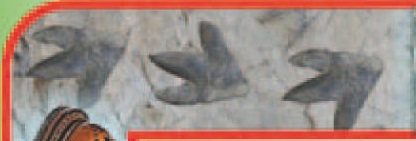the place where Paleontology and Paleoanthropology meets Philately
Spain
Fossils, dinosaurs and other prehistoric animals, Natural History Museums, Charles Darwin, cave painting, fossil
found places on stamps and postmarks of Spain
| << previous country | back to index | next country >> |
Contents:
- Country overview
- Philately of Spain
- Official stamps of Spain related to Paleontology
- Some personalized stamps of Spain related to Paleontology
- Other stamps of Spain to consider
- Commemorative postmarks of Spain related to Paleontology
- Other postmarks of Spain to consider
- References
- Acknowledgements
Spain, officially the Kingdom of Spain is a sovereign state largely located on the Iberian Peninsula in southwestern Europe, with two large archipelagos, the Balearic Islands in the Mediterranean Sea and the Canary Islands off the North African Atlantic coast, two cities Ceuta and Melilla on the North African mainland and several small islands in the Alboran Sea near the Moroccan coast.
It is the only European country to have a border with an African country (Morocco) and its African territory accounts for nearly 5% of its population, mostly in the Canary Islands but also in Ceuta and Melilla.
Spain has an area of 505,990 km2 and population of over 46 million. [R1]
The very first stamp of Spain issued in 1850, but it took 75 years until some dinosaurs appeared on Spanish stamps.
However, there were many postmarks and a few stamps that show prehistoric animals from cave paintings from the Altamira Cave.
Stamps in Spain are distributed and sold by the Spanish postal service known as the Correos y Telégrafos, and beginning in 2001 officially a governmental corporation, the Sociedad Estatal de Correos y Telégrafos, S.A. Since 2011 the corporation and its subsidiaries are known as the "Grupo Correos". [R2]
There are several philatelic clubs in various regions of Spain who produce some personalized stamps with fossils and reconstruction of prehistoric animals who roamed their areas in the past.
Official stamps of Spain related to Paleontology and Paleoanthropology: fossils, dinosaurs and other prehistoric animals, early humans, Charles Darwin
| 30.11.2001 "UNESCO world heritage sites" [1] | 15.07.2009"Popular Characters" [2] | 11.07.2012"Science" |
 |
 |
 |
| 07.05.2015 "Dinosaurs" (I) [3] | 30.06.2016 "Dinosaurs" (II) [4] | 02.10.2017 "Teruel province" [5] |
 |
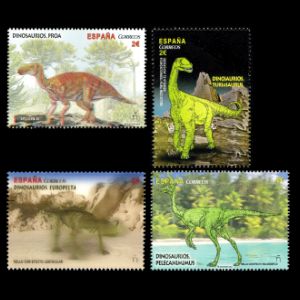 |
 |
| 02.05.2019 "La Rioja province" [6] | 23.03.2020 "Museum of Human Evolution in Burgos" [7] | |
 |
 |
 |
| 19.04.2023 - "JUVENIA, Teruel, Dinosaurs - Aragosaurus Ischiaticus" | 19.04.2023 - "Liopleurodon" (ATM stamps - Teruel) | |
 |
 |
 |
| 19.04.2023 - "Liopleurodon" (ATM stamps - Madrid) | 21.04.2023 - "Liopleurodon" (ATM stamps - Albarracin ) | |
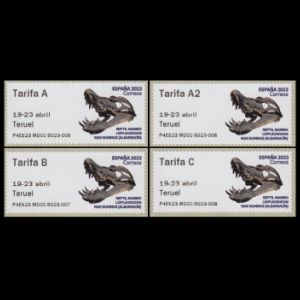 |
 |
|
Notes:

|
| Paleoanthropological excavation at Atapuerca and a skull of Homo erectus on stamp of Spain 2001 MiNr.: 3682, Scott: 3130e |
The Archaeological Site of Atapuerca is located near the city of Burgos, in the Autonomous Community of Castilla y León, in the North of the Iberian Peninsula. The property hosts a rich fossil record of the earliest human beings in Europe, from nearly one million years ago and extending into the Common Era.
It constitutes an exceptional scientific reserve that provides priceless information about the appearance and way of life of these remote human ancestors.
The Sierra de Atapuerca sites provide unique testimony of the origin and evolution both of the existing human civilization and of other cultures that have disappeared.
The evolutionary line or lines from the African ancestors of modern humankind are documented in these sites. [R3]
[2] Charles Darwin depicted on one of the stamps.
[3] On May 7, 2015, Post Authority of Spain issued the first stamps of Dinosaurs.
The set contain four stamps each one printed with different technique: scales texture, Augmented Reality, phosphorence, and 3D. They also provided special glasses which can be used to see some of these effects.
All of the dinosaurs depicted on these stamps are “classic” dinosaurs, well known to the public. Unfortunately, none of these fossils are found in Spanish rocks.
The dinosaurs are reconstructed in the fashion of a child’s drawing. Another weakness of these stamps is their price.
Two euros is very expensive, even for an European country – and made the use of these stamps for postage very limited.
It seems that these stamps were released with the purpose of selling them to collectors instead of for use as postage – therefore these stamps are marked as undesired.
[4] On June 30, 2016, Post Authority of Spain issued the second stamps of Dinosaurs (first set issued in 2015).
Similar to the stamps from 2015, the set contain four stamps each one printed with different technique: scales texture, Augmented Reality, phosphorence, and 3D. They also provided special glasses which can be used to see some of these effects.
The 2015 issues showed well known dinosaurs like Ankylosaurus, Triceratops, Tyrannosaurus, and Diplodocus.
This second set showed dinosaurs that actually lived on the Iberian Peninsula in the past.
Two euros was very expensive, making their use as postage very limited. It seems that these stamps were issued with the purpose of selling them to collectors instead – and they are marked as undesired.
[5]

|
| Aragosaurus dinosaur on Teruel stamp of Spain 2017, MiNr.: 5199, Scott: 4169. |
At the bottom-right corner of the stamp, one can see a dinosaur’s head. The head belongs to the dinosaur, Aragosaurus.
Aragosaurus (meaning "Aragon lizard") was a genus of sauropod dinosaur from
the Early Cretaceous period of Galve, province of Teruel, in the autonomous
territory of Aragón, Spain.
Aragosaurus was a large, quadrupedal plant-eating dinosaur, which lived about
133-125 million years ago.
It was about 18 metres in length and about 28 tonnes in weight.
Like other sauropods, it had a long neck, a long powerful tail, a small head and a bulky body.
[R15]
Another dinosaur found in Teruel province is Turiasaurus
riodevensis, who was also a sauropod dinosaur, and is believed to be the largest dinosaur ever found
in Europe, and is among the largest dinosaurs known to date, at 36–39 metres in
length and with a weight of 40 to 48 tonnes.
[R16]
[6] Dinosaur's footprint depicted on the left side of the stamp "12 MONTHS 12 SEALS. THE RIOJA".
More than 120 million years ago in this place, Enciso, lived dinosaurs.
They lived in a unique enclave, in the ancient Sea of Tethys, where they left their mark.
Today we continue to be amazed with its habitat, its diet, its way of life, hunting ... that is, with the authentic nature of the great saurians.
[7] This year, three new Spanish museums are the central figures of the series Correos dedicates to the temples of art, history and culture in Spain.
The first of the Premium Sheets is dedicated to the Museum of Human Evolution.
Located in the center of Burgos, it was designed by the architect Juan Navarro Baldeweg on a plot where the convent of San
Pablo of the Dominican order once stood many centuries back.
The museum was included in the declaration of the sites of Atapuerca as a World Heritage Site in 2015.
The main aim of the Museum of Human Evolution is to preserve, map and disclose archaeological remains from the sites of
the Sierra de Atapuerca.
The façade of the museum is seen in the stamp’s motif, together with an image of the human skull known as Miguelón.
Some personalized stamps of Spain related to Paleontology and Paleoanthropology: fossils, prehistoric animals
| 03.08.2012 "30 years since discovery Mammoths fossils at Padul (Granada), Spain" [SP1] | 16.08.2013 "Ancient human from Orce" [SP2] | 28.08.2015 "Saber-toothed tiger: Megantereon whitei" [SP3] |
 |
 |
 |
| 07.05.2015 "XLVII International stamps show in Madrid" | ||
 |

| |
| 03.10.2017 "Mastadon from Baza: Anancus arvernensis" [SP4] | 17.01.2019 "25th anniversary of Fossil and Minerals Museum of Elgoibar" [SP5] | 26.10.2019 "Fossils of Aragon" [SP6] |
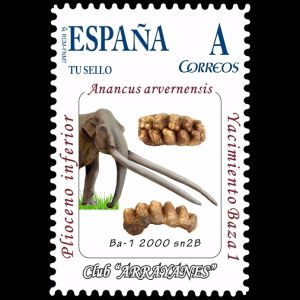 |
 |
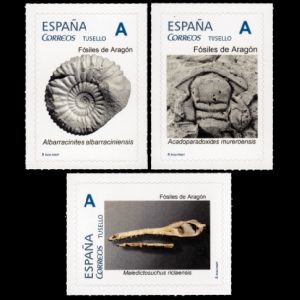 |
Notes:
[SP1] Issued by the Granada Philatelic and Numismatic Society and the Arrayanes Collectors Club, to commemorate the 30th anniversary of the "great "Discovery, in 1982, of the remains of the woolly mammoth (Mammuthus primigenius), in the so-called" peat bog "of La Laguna, in the Granada town of El Padul. [R12]
[SP2] Issued by Granada Philatelic and Numismatic Society, the Arrayanes Collectors Club, of Granada, the City Council of Orce and the scientific team of the IPHES (Institut Català de Paleoecologia Humana i Evolució Social ).
The stamp shows a "milk" tooth of 10 years old child, found at Orce, Granada province of Spain.
The tooth is about 1.4 million years old and is one of the oldest human fossils in Europe. [R13]

|
| Megantereon whitei on stamp of Gibraltar 2000 MiNr.: 915, Scott: 841b |
[SP3] The stamp show a jaw of Saber-toothed tiger: Megantereon whitei, that was discovered at "Venta Micena" site by Orce village at Granada province of Spain.
Issued by "Arrayanes" Collectors Club of Granada to commemorate 20 years since publication of "Presence of the African Machairodont Megantereon whitei (Broom, 1937) (Felidae, Carnivora, Mammalia) in the Lower Pleistocene Site of Venta Micena (Orce, Granada, Spain), with some Considerations on the Origin, Evolution and Dispersal of the Genus". [R14]
[SP4] Issued by "Arrayanes" Collectors Club of Granada.
The stamp shows reconstruction and some fossils of Anancus arvernensis, a species of Madodon, that was found in the Bastetan paleontological deposit called "Baza-1", excavated in summer 2017. [R10]
[SP5] On celebration of its 25th anniversary Mufomi Fossils and Minerals Museum of Elgoibar issued two personalized stamps.
One stamp shows a mineral, the other shows an ichthyosaur, one of the species of the genus Mixosaurus. Ichthyosaur is the general group; Ichthyosaurus is a specific genus of ichthyosaur.
Mixosaurus was a small to medium-sized ichthyosaur, not growing more than 2 meters in total length with small species not growing more than 1 meter. [R17]
Mufomi, in Elgoibar, offers the largest collection of fossils and minerals in Euskadi (an autonomous community in northern Spain ).The museum is divided into two rooms.
The first one is dedicated to invertebrate fossils and fossils from Euskadi.
In the other room are exhibited vertebrate fossils and minerals collected from other corners of the world.
Pity they depict a foreign animal (Mixosaurus fossils have been found near the Italy–Switzerland border and in South China) instead of a local one.
[SP6] Issued by the Society of Friends of the Museum of Natural Sciences of the University of Zaragoza (SAMPUZ) and Philatelic Association Zaragozana (ASFIZA), with the purpose to promote fossils of Aragon in different locations of Spain and even abroad.
Aragon is a landlocked, autonomous, region in northeastern Spain comprising the provinces of Huesca, Zaragoza and Teruel.
Its capital is Zaragoza (also called Saragossa in English).
Fossils on stamps include:
Ammonite Albarracinites albarracinensis from Albarracín (Teruel)
Trilobite Acadoparadoxides mureroensis from Mureo (Zaragoza)
Skull of marine crocodile Maledictosuchus riclaensis from Ricla (Zaragoza). [R9]
Other stamps to consider: fossils found places, cave painting, Natural History Museums
| 27.03.1967 "Painting (XI): Prehistoric cave painting" | 18.07.1969 "Gibraltar" [A1] | 28.04.1975 "Europe: Painting" [A2] |
 |
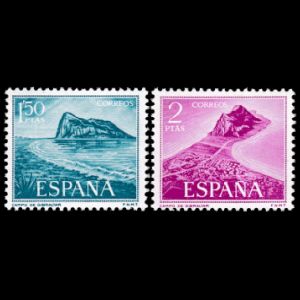 |

|
| 05.12.1989 "UNESCO heritage (III)" [A3] | 27.04.2015 "World Heritage. Cave of Altamira" [A3] | 10.03.2016 "Museum of Natural Sciences" [A4] |
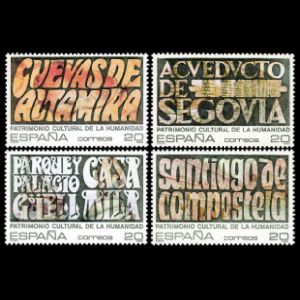 |
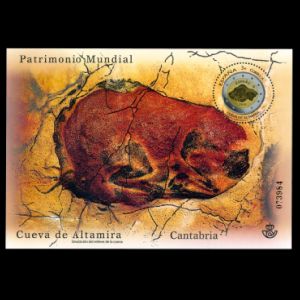 |
 |
| 29.05.2020 "MINERALS. Azabache (JET)" [A5] | 27.03.2025 "National Museum and Research Center of Altamira" [A3] | |
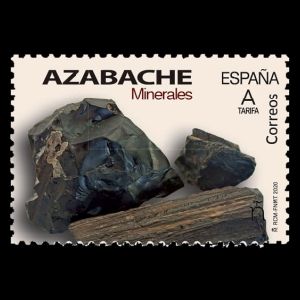 |
 |
|
Notes:
[A1] The Rock of Gibraltar shown on both stamps.
The Gibraltar Neanderthals first came to light in 1848 during excavations in the course of the construction of a fortification called Forbes' Barrier at the northern end of the Rock of Gibraltar.
The skull of a Neanderthal was discovered in Forbes' Quarry by Lieutenant Edmund Flint, though its exact provenance is unknown, and was the subject of a presentation to the Gibraltar Scientific Society by Lieutenant Flint in March 1848 [R4].
The Rock of Gibraltar is also depicted on several stamps of Gibraltar.
[A2] Prehistoric horse shown on one of the cave painting stamps.
[A3] "Cave of Altamira" and Bison priscus, also called Steppe Bison, depicted on the background.
The bison is from the painting found in the cave, it can can also be seen on stamp from 2015 as well as on many postmarks of Spain.
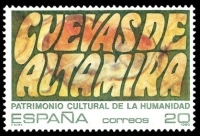
|
| The steppe bison, Bison priscus from painting in the Cave of Altamira on stamp of Spain 1989. MiNr.: 2918, Scott: 2613 |
The steppe bison or steppe wisent is an extinct species of bison that was once found on the mammoth steppe where its range included Europe. Steppe bison appear in cave art, notably in the Cave of Altamira and Lascaux, and the carving Bison Licking Insect Bite, and have been found in naturally ice-preserved form. [R5]
The Cave of Altamira, declared a World Heritage Site by UNESCO in 1985, is the reason for this isue consisting of a block leaf, printed with a slight relief to simulate the original cave, reproduces one of the best known rock paintings.Located in the municipality of Santillana del Mar (Cantabria), Altamira Cave was the first place in the world to identify the existence of rock art during the Upper Palaeolithic period.
The discovery was made by the scholar Marcelino Sanz de Sautuola, who visited the cave for the first time in 1875, when official science did not admit the existence of art in the Paleolithic period.
The cave is more than 270 meters long, with an irregular layout of different rooms, covered with paintings made some 15,000 years ago.
The most famous is the polychrome ceiling, with figures of large red horses, bison, deer, bulls, hands painted in positive and negative, signs, points and other representations. [R6]

|
| Megatherium americanum on margin of stamp sheet of Spain 2016 MiNr.: 5046, Scott: |
[A4] The Museo Nacional de Ciencias Naturales (Spanish: National Museum of Natural Sciences) is the National Museum of Natural History of Spain.
It is situated in the center of Madrid, by the Paseo de la Castellana.
It is managed by the Spanish National Research Council. The Museum was created in 1772 by Charles III of Spain as the Gabinete Real de Historia Natural, changing names several times until its current denomination.
The museum has significant collection of fossils, for example:
A Megatherium americanium brought from Argentina in 1789 and depicted on margin of stamps sheet (bottom-right corner)
A Diplodocus donated by Andrew Carnegie to Alfonso XIII of Spain. [R7]
[A5] The famous Asturian jet (also called black amber) is an organic gemstone, highly valued for its excellent cutting qualities, and attaining a typical shine and intense black colour after polishing.
Specialist studies determine that the woody material, which becomes a humic carbon, perihydrogenated during the Kimmeridgian age (Late Jurassic) around 155 million years ago, underwent particular circumstances while it formed, such as impregnation with hydrocarbons, which gives it some of its unique features and exceptional stability for use in jewelry making.
Commemorative postmarks of Spain related to Paleontrology: fossils, dinosaurs and other prehistoric animals, prehistoric humans, footprints of prehistoric animals, Charles Darwin
Legend is here| 14.02.1970 "Inauguration Academic of the provincial institute of paleontology in Sabadell" [Sp] | 09-12.09.1974 "1st Symposium of Iberian Cretaceous" [Sp] | ?.1980 [DU] "3rd International Minerals and Fossils trade show in Bilbao" [Sp] |
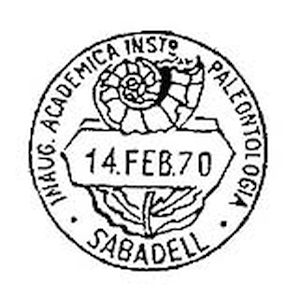 |
 |
 |
| 18.10.1980 "3rd International Exhibition of minerals and fossils in Bilbao" [Sp] | 11.02.1983 "25th anniversary of Geological Museum in Granada" [Sp] | 22.10.1983 "6th International Minerals and Fossils trade show in Bilbao" [Sp] |
 |
 |
 |
| 02.11.1983 "1st Exhibition geological sciences in Andalusia" [Sp] | 19-20.10.1985 "8th International Minerals and Fossils trade show in Bilbao" [Sp] | 15.11.1992 "Philatelic show Fossils and Minerals" [Sp] |
 |
 |
 |
| 1992 "SHD" [DU] [PM] - |
08.05.1993 "Philatelic show in Museu Balear de Ciències Naturals" [Sp] | 13-14.10.1994 "Philatelic show - Geology on stamps, in Zaragoza" [Sp] |
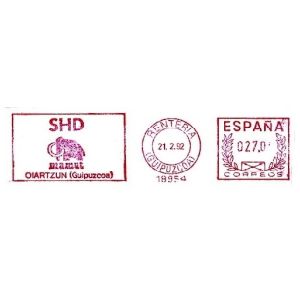 |
 |
 |
| 04.09.1995 "International Congress of Human Paleontology" [Sp] | 11.11.1995 "Philatelic show - Minerals and Fossils in Urretxu" [Sp] | 12.11.1997 "Bicentennials of famous geologists: James Hutton (1726-1797), Casiano de Prado y Valle (1797-1866), Sir Charles Lyell (1797-1875)" [Sp] |
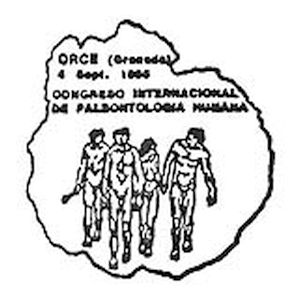 |
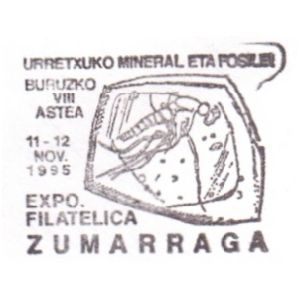 |
 - |
| 15.11.1997 "Fossils and Minerals show in Zumarraga" [Sp] | 16-18.06.2000 "IV collectors show in Pamplona-Jruna" [Sp] | 04.11.2000 "Fossils and Minerals show in Zumarraga" [Sp] |
 |
 |
 |
| 21.11.2000 "International philatelic show - First inhabitant of Europe" [Sp] | 11.11.2001 "VII Aragonese Conference of Paleontology in Ricla" [Sp] | 30.11.2001 "World heritage of humanity" [FDC] |
 |
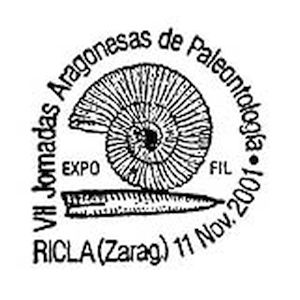 |
 |
| 15.07.2009 "Popular characters: Charles Darwin" [FDC] | 11.07.2012 "Science: Paleontology" [FDC] | 07.05.2015 "Dinosaurs (I)" [FDC] |
 |
 |
 |
| 07.05.2015 "Dinosaurs (I)" [FDC] | ||
 |
 |
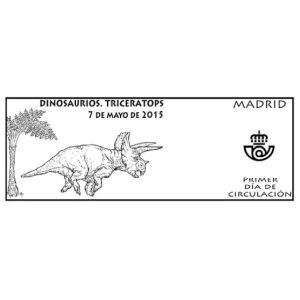 |
| 07.05.2015 "Dinosaurs (I)" [FDC] - |
||
 |
 |
 |
| 07.05.2015 "Dinosaurs (I)" [FDC] | 30.06.2016 "Dinosaurs (II)" [FDC] | |
 |
 |
 |
| 30.06.2016 "Dinosaurs (II)" [FDC] | ||
 |
 |
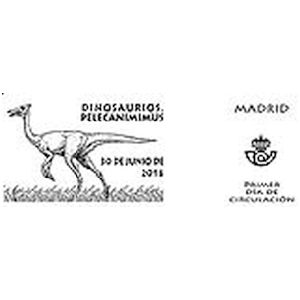 |
| 18.01.2019 "25th anniversary Mufomi Fossils and Minerals Museum of Elgoibar" [Sp] | 23.03.2020 "Museum of Human Evolution in Burgos" [FDC] | 19.04.2023 - "JUVENIA, Teruel, Dinosaurs - Aragosaurus Ischiaticus" [FDC] |
 |
 |
 |
| 19.04.2023 - "JUVENIA, Teruel, Dinosaurs - Aragosaurus Ischiaticus" [FDC] | 19.04.2023 - "JUVENIA, Teruel, Dinosaurs - Aragosaurus Ischiaticus" [FDC] | 19.04.2023 - 2023 - "Liopleurodon" [FDC] |
 |
 |
 |
| 21.04.2023 - 2023 - "Liopleurodon" [Sp] | ||
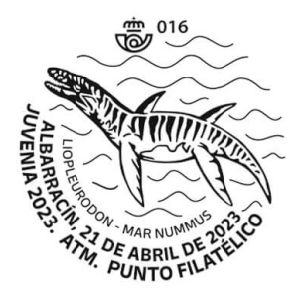 |
|
|
Some commemorative postmarks of Spain to consider: prehistoric animals on cave painting, fossil found places, Natural History Museums
Legend is here| 02.09.1957 "5th Congress on the Study of the Quaternary, Madrid." [Sp] [CO1] | 15.03.1983 "Statute of autonomy for Cantabria" [FDC] [CO1] | 05.12.1989 "UNESCO cultural heritage (III) - Santillana del Mar" [FDC] [CO1] |
 |
 |
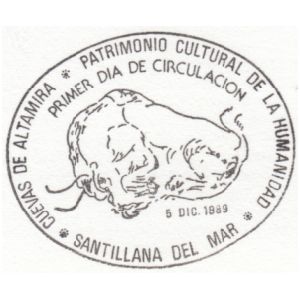 |
| 12.05.1989 "World Heritage" [Sp] [CO1] | 27.11.1994 "Expofil'94 exhibit" [Sp] | 04.05.1997 "Exficoluc'97" [Sp] |
 |
 |
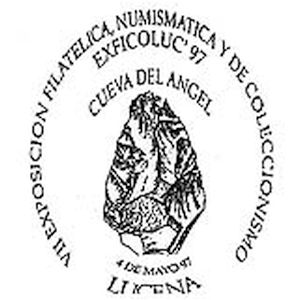 |
| 09.10.1997 "Exfilna'97 - Juvenile Philately Day" [Sp] | 08.11.2003 "VIII Aragonese Days of Paleontology in Ricla" [Sp] | 11.07.2013 "XXV anniversary of philatelic Federation of Cantabria" [Sp] |
 |
 |
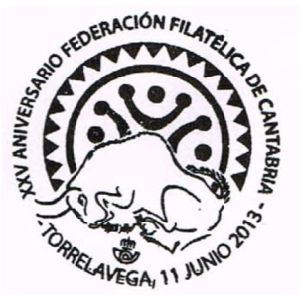 |
| 27.04.2015 "World Heritage. Cave of Altamira"" [FDC] [CO1] - |
04.08.2015 "Altamira Museum. Santillana del Mar" [Sp] [CO2] | x.02.2015 "Official postmark of post office at Altamira cave" [PM] |
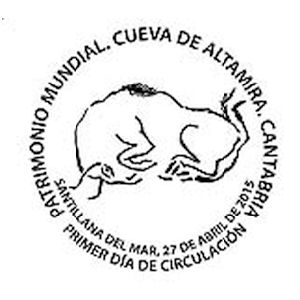 |
 |
 |
| 10.03.2016 "Museum of Natural Sciences" [FDC] [A4] | 10.03.2016 "Museum of Natural Sciences" [Sp] [A4] | 11.10.2016 "Altamira Museum" [Sp] [CO2] |
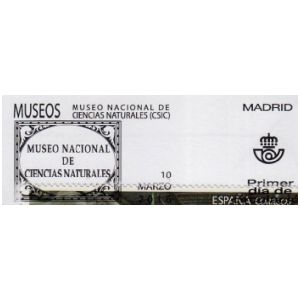 |
 |
 |
| 15.07.2018"Altamira Museum - Altamira cave painting in philately" [Sp] [CO2] | 01.10.2019 "12 months 12 stamps: Cantabria" [FDC] [CO2] | 27.03.2025 "Altamira Research Center Museum" [FDC] |
 |
 |
 |
Notes:
[CO1] Steppe bison from cave painting in Altamira cave [A3]
[CO2] The National Museum and Research Center of Altamira (Spanish: Museo Nacional y Centro de Investigación de Altamira) is a center dedicated to the conservation of, research into and the sharing of information about the cave of Altamira in Santillana del Mar (Cantabria, Spain), named a World Heritage Site by Unesco. [R8]
References:
- [R1] Spain: Wikipedia, Wikitravel or FlagCounter
- [R2] Postal History and Philately of Spain and the Spain: Wikipedia, Links to official website of the Post Authority, stamp catalog and a list of new stamps of South Georgia and the Spain are here.
- [R3] Archaeological Site of Atapuerca: UNESCO web site.
- [R4] Neanderthals of Gibraltar: Wikipedia.
- [R5] Steppe bison: Wikipedia.
- [R6] Cave of Altamira: Wikipedia.
- [R7] National Museum of Natural Sciences: Wikipedia, official website of the museum.
- [R8] The National Museum and Research Center of Altamira: Wikipedia, Official website of the museum.
- [R9] Fossils of Aragon: folklore-fosiles-ibericos.blogspot.com.
- [R10] Mastodon from Baza: folklore-fosiles-ibericos.blogspot.com, Ayuntamiento de Baza.
- [R11] Postmark commemorating the celebration of the Bicentennials of James Hutton, Casiano de Prado and Sir Charles Lyell, at the University of Oviedo: folklore-fosiles-ibericos.blogspot.com.
- [R12] The woolly mammoths from Padul: folklore-fosiles-ibericos.blogspot.com, Philatelic and Numismatic Society of Granadina.
- [R13] The ancient humans of Orce: folklore-fosiles-ibericos.blogspot.com.
- [R14] The African saber-toothed tiger of Orce: folklore-fosiles-ibericos.blogspot.com.
- [R15] Aragosaurus: Wikipedia.
- [R16] Turiasaurus: Wikipedia.
- [R17] Mixosaurus: Wikipedia.
Acknowledgements:
Many thanks to Dr. Peter Voice from Department of Geological and Environmental Sciences, Western Michigan University, for reviewing the draft page and his very valuable comments.| << previous country | back to index | next country >> |
